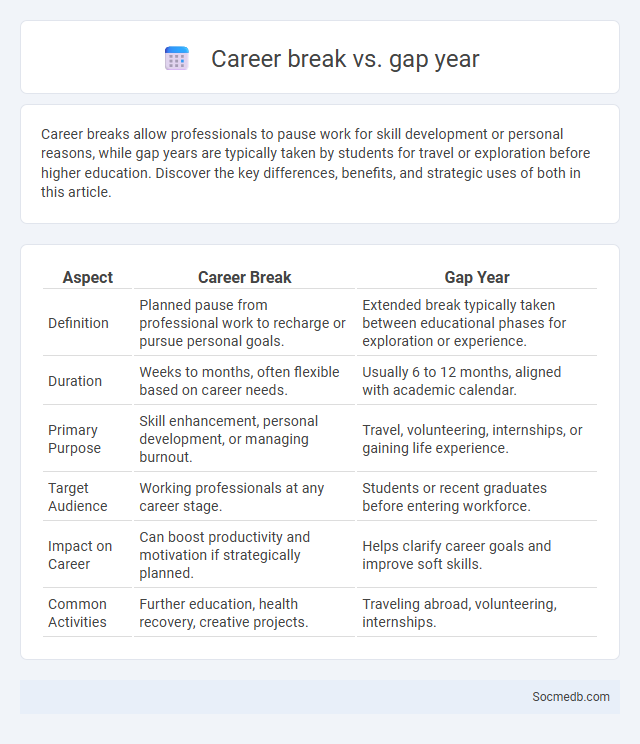
Photo illustration: Career break vs Gap year
Career breaks allow professionals to pause work for skill development or personal reasons, while gap years are typically taken by students for travel or exploration before higher education. Discover the key differences, benefits, and strategic uses of both in this article.
Table of Comparison
| Aspect | Career Break | Gap Year |
|---|---|---|
| Definition | Planned pause from professional work to recharge or pursue personal goals. | Extended break typically taken between educational phases for exploration or experience. |
| Duration | Weeks to months, often flexible based on career needs. | Usually 6 to 12 months, aligned with academic calendar. |
| Primary Purpose | Skill enhancement, personal development, or managing burnout. | Travel, volunteering, internships, or gaining life experience. |
| Target Audience | Working professionals at any career stage. | Students or recent graduates before entering workforce. |
| Impact on Career | Can boost productivity and motivation if strategically planned. | Helps clarify career goals and improve soft skills. |
| Common Activities | Further education, health recovery, creative projects. | Traveling abroad, volunteering, internships. |
Understanding Career Breaks: Definition and Purpose
Understanding career breaks involves recognizing a temporary pause in professional activities to pursue personal growth, education, or family commitments. These intentional breaks allow you to recharge, acquire new skills, or address life priorities without severing career paths. Clarifying the purpose and structure of your career break enhances its positive impact on long-term professional development.
What is a Gap Year? Key Features and Intentions
A gap year is a planned break typically taken between high school and college or during university to pursue personal growth, travel, work, or volunteer experiences that enrich your skills and worldview. Key features include structured time off from formal education, opportunities for real-world learning, and intentional exploration of interests and career paths. The primary intention of a gap year is to provide you with meaningful experiences that enhance maturity, self-awareness, and future academic or professional success.
Career Break vs Gap Year: Core Differences
A career break typically involves taking time off from professional work to recharge, upskill, or handle personal matters, while a gap year is usually a planned period between educational stages dedicated to travel, volunteering, or exploring new interests. Your choice between a career break and a gap year impacts social media content, as career breaks often highlight professional development and networking, whereas gap years emphasize cultural experiences and personal growth. Understanding these core differences helps tailor your social media strategy to resonate with your audience's expectations and aspirations.
Common Reasons for Taking a Career Break
Career breaks on social media often stem from burnout due to digital overload, the need for mental health recovery, and the pursuit of personal growth or new skills outside the online environment. Many professionals pause their social media presence to reduce stress and regain focus, highlighting the platform's impact on work-life balance. Time off also allows for reevaluation of career goals and enhanced creativity, essential for sustainable success in digital industries.
Popular Gap Year Activities and Opportunities
Popular gap year activities often include volunteering, internships, and cultural immersion programs, which offer valuable real-world experience and personal growth. Social media platforms enable gap year participants to share their journeys, connect with like-minded individuals, and access exclusive opportunities such as scholarship programs and travel discounts. Engaging actively on Instagram, TikTok, and LinkedIn enhances visibility and network-building, creating pathways to global gap year projects and career development.
Impact on Career Progression: Breaks vs Gaps
Social media presence significantly influences career progression, with continuous activity (breaks) maintaining professional visibility and network engagement, whereas extended inactivity (gaps) can raise concerns about skill stagnation or disengagement. Recruiters and employers increasingly analyze candidates' online profiles to assess consistency in career development and industry involvement. Strategic social media use helps reinforce expertise, showcase achievements, and mitigate potential negative perceptions associated with employment gaps.
Financial Implications: Planning for Time Away
Social media management requires careful financial planning for time away, as pauses can impact advertising revenues and influencer partnerships. Budgeting for content creation and scheduling tools ensures consistent engagement during breaks. Allocating funds for emergency promotions helps maintain brand visibility despite temporary inactivity.
How Employers View Career Breaks and Gap Years
Employers increasingly recognize career breaks and gap years as valuable periods for personal growth, skill development, and gaining diverse experiences that enhance your professional profile. Many hiring managers appreciate candidates who use social media to highlight productive activities during these gaps, such as volunteering, freelancing, or pursuing further education. Presenting your gap year with a clear narrative and demonstrated achievements can positively influence employers' perceptions and expand your career opportunities.
Tips for Explaining Your Break or Gap on a CV
Clearly outline the reason for your break on your CV, emphasizing skills gained during that period, such as volunteering, freelancing, or further education. Use concise, positive language to demonstrate growth and how the experience enhances your suitability for the role. Tailor your explanation to align with the job requirements and maintain transparency to build trust with potential employers.
Making the Most of Your Time Off: Strategies for Success
Maximizing your time off involves strategically managing social media to balance relaxation and productivity. Use scheduling tools to plan posts ahead, ensuring consistent engagement without constant online presence. Prioritize meaningful interactions and content creation to make the most of your social media efforts during breaks.
 socmedb.com
socmedb.com